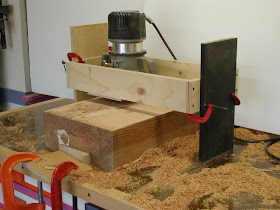December 22, 2006. That's the day when Marc Spagnuolo published A Cut Above, the Wood Whisperer podcast episode that transformed the end-grain cutting board from a utilitarian kitchen accessory to a near rite of passage among fledgling woodworkers everywhere.

In the video, Marc shows how to keep the boards aligned during the glue-up to minimize the need for sanding later. But if your pieces aren't cut exactly right, or if one of them slips without being noticed during the final glue-up, it's entirely possible to end up with a cutting board that's needs to be flattened before you can finish it.
Your first thought at this point might be, "I'll just run the board through my planer." That sounds like a reasonable idea, but DON'T DO IT! Planers don't like to plane end grain. Even with extreme care, there's a really good chance that you'll destroy the board, and maybe the planer as well.
So what to do? If you have a thickness sander (or access to one), that's the way to go. If you don't, you might have success with a hand-held belt sander or with hand planes. However, it takes some finesse to get a board flat with a belt sander, and it's not especially easy to use a hand plane on end grain.
In the absence of a thickness sander, another option is to use a router and a jig. This setup is really neat, even though it would certainly be overkill for a little cutting board. This one is similar, but scaled down a bit for smaller boards. Both of these jigs (and many others) rely on some sort of straight rail system to guide the router.
It occurred to me that a flattening jig might use the surface of a workbench or assembly table as a reference, instead of having rails built into the jig. With that idea in mind, I came up with this very simple jig:
It acts as a bridge, suspending the router a fixed distance above the workbench. To use it, I secured the workpiece to the workbench, and then just slid the jig around on the workbench to flatten the board. I didn't have a cutting board to try it out on, so I used a big block of fir that I had laying around instead.
I got some burn marks that started after the cheap HSS router bit I was using got dull when I went through a big knot. I don't think you would get this burning with a decent, sharp carbide bit in clear lumber.
For this experiment, I just clamped the legs on either end of the jig to raise it above my big thick block. For most applications, where the workpiece would typically be an inch or two thick, you could attach the legs permanently and then tweak the router itself for small vertical adjustments.
I mounted the router a third of the way from one end of the jig. With this arrangement, if you plane the right half of the board with the router oriented towards the right, then turn the jig around the other way to do the left half, you can plane boards that are 2/3 as wide as the jig is long. If you mount the router in the middle of the jig, there's no need to turn the jig around, but you'll be more limited in the width of boards that you can flatten.





Definitely the only safe way to flatten an end-grain board. i like the simplicity of your setup. I would have been adding screws and glue all over (for nothing).
ReplyDeleteFor the bit, take a look at the bowl bits. I think you'll like the result. It has a wide flat bottom with rounded edges. In a way a lot like a cambered plane iron so the curves take out 'tracks' from previous passes. I bought one once and love it for this type of chore.
I have a Rockler one, but this one from Eagle would be good:
http://www.eagleamerica.com/product/vp13-2502/pc_-_groove_forming
Good idea on using a bowl bit, although I was amazed on my test block that there really weren't any "tracks" like you're talking about. I must have lucked out and attached the legs to the jig so that the axis of the router was perfectly perpendicular to the workbench surface. I dunno if I can repeat that or not.
ReplyDelete